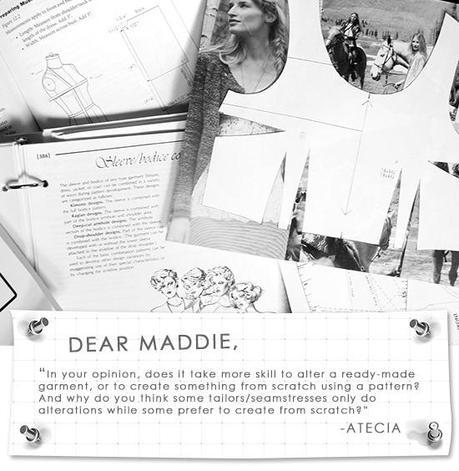In my opinion, both altering a garment and making one from scratch requires skill. One is not harder than the other, rather, each one requires different techniques and methods. Also, each one is suited for different types of sewers. While one sewist loves bringing life to a worn and outdated garment, another hates messing with something that is already constructed. One aspect of my sewing career that I’m especially grateful for is that started by getting my feet wet in both fields. When I worked at Mishka’s tailor shop, I helped create patterns and make garments from scratch (I remember replicating this dress for one client. That was fun!), but I also hemmed jeans (keeping the original hem) and shortened cuffed, men’s sleeves (that was a hassle!).
Specifics… specifics… you want specific examples on what I’m talking about, right? From my experience working at Mishka’s and the trickling of alterations I’ve done since, here are my pros, cons, upsides, downsides, viewpoints, or whatever you want to call it, for altering and making clothes.

There is a different order of operations when altering clothes. When sewing a garment from scratch, the sequence is 1, 2, 3, 4 and so on, but when changing a garment after it’s been made, the sequence can be backwards – 4, 3, 2, 1 – or mixed up – 4, 2, 3, 1. Let’s pretend you have a pair of pants that fit everywhere except the back waist – it sticks out and let’s places that the sun don’t shine, well, shine. What do you do? Well, what Mishka and I did was add 2 darts on either side of the CB seam. Detaching the waistband from side seam to side seam (don’t remove the entire thing!), we added darts mid panel. If there were pockets, we would try to be very careful and sew around them, but if we couldn’t, we’d detach them (and reattach after the alteration). Of course, it’s always a hassle getting things back into their original place and without any signs of alterations.

Because the garment is already sewn, you have to work with what you got, and sometimes the results are not ideal. Case in point is a denim overalls someone at work asked me to alter. It fits everywhere except the hips. If it were a perfect world, I would reduce the side seams, but because it’s denim and because the seams are flat felled, it would be very hard for me to replicate the same type of stitching – any onlooker would know the garment had been altered. Solution? We’re contemplating adding a soft elastic to the waistband by cutting a slit on the interior, inserting the elastic, and closing up the slit with a patch that is only visible on the interior. This route would give her waist definition, which is more flattering, but also disguise the bulging hips.

Pamela said that the best thing she ever made wasn’t a particular garment, but a type of sewing – upcycling. When she was younger, she redid old wedding dresses for new brides and loved rejuvenating near dead garments. For some sewers, altering is their thing, especially when it comes to making vintage garments modern and current.
Now I turn the question to you. What do you prefer – altering garments or making them from scratch?





